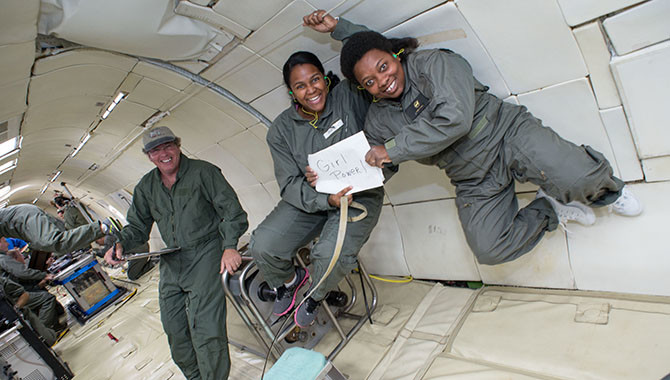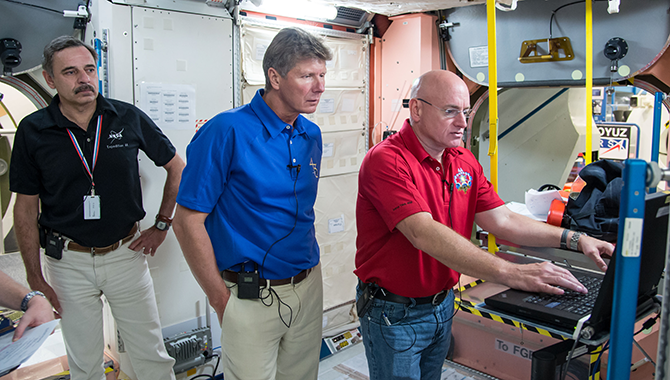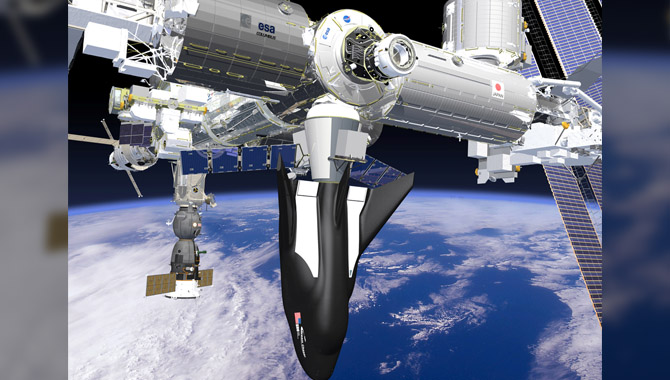
From left to right, Jim Wagner, Rochelle May, and Nancy Hall are on the Zero-G Corp 727, a reduced gravity aircraft where experimental hardware is tested in a microgravity environment. The aircraft flies in parabolic arcs to generate 20-30 seconds of weightlessness.
Photo Credit: NASA / Robert Markowitz
For Nancy Rabel Hall, a love of science and learning paved the way to becoming a project manager at Glenn Research Center (GRC).
Hall is a project manager in the ISS and Human Health Office at GRC, where she currently manages four projects destined to be flown on the International Space Station (ISS). Despite her success, Hall didn’t follow a typical path to project management. APPEL News sat down with her to find out how her passionate interest in science and life-long dedication to learning led her to a position that is traditionally held by individuals with a technical background. Hall shared her philosophy that success stems from loving what you do—and giving back to others.
APPEL News: Let’s start at the beginning. How did you get involved with science—and with GRC?
Nancy Hall: I grew up in Brooklyn, N.Y., where my sixth grade teacher got me interested in science. Class was so fun because it was really hands-on. For example, we did all sorts of experiments, the teacher had hamsters in the class and each weekend kids got to take the hamsters home, we had goldfish, chameleons—all sorts of interesting stuff. Plus, I loved science fiction books, Star Trek, and Star Wars. So that led me one day to say: I want to be a scientist! I concentrated on math and physics courses in high school and then I went on to get a BS in Space Sciences from the Florida Institute of Technology. My Space Sciences degree was broad based. It was primarily physics and astronomy, but it also provided a background in computer science, mechanical engineering, and math.
I joined Glenn after college and was assigned to work on the Space Station Freedom project. Eventually I transferred to the Microgravity Science Division, where I started as a project scientist and later became a project manager in the ISS and Human Health Office. I received my Masters in Mechanical Engineering from the University of Toledo while working at NASA. I took courses on topics that were directly related to the projects I was working on, like two-phase flow, advanced engineering math, conduction, convention, radiation, and transport phenomena—basically, different behaviors of liquid from a fluid mechanics standpoint, which is a subset of Mechanical Engineering.
APPEL News: So you worked full time at Glenn while pursuing an advanced degree. Was it difficult to do both?
Hall: Actually, taking classes while working here is one of the neat things about being at NASA. It’s important—this is something I emphasize when I do educational outreach with students—because technology is constantly changing so we need to keep up. I like having the opportunity to focus on training. APPEL is a perfect example. In our performance plans, “project management excellence” is something our managers promote. So APPEL courses can really help. We can also get external courses funded through our projects or our training branch. I’ve taken courses to help me both as a project scientist and as a project manager.
APPEL News: Can you tell us a bit about your role as a project scientist compared with your work now as a project manager?
Hall: As a project scientist, I was the liaison between the science team and the engineering team. A project scientist has to understand the science and be able to explain to the engineers what the principal investigator [PI] wants them to build. And he or she also has to have enough of an engineering background to tell the PI whether the design he wants to build is feasible—or impossible. So as a project scientist, you’re playing a dual role.
Being a project manager is different. You’re basically managing the engineering team that’s designing and building the experiment, making it sure it meets the science specifications and engineering requirements, while at the same time you’re collaborating with the project scientist. And you also have the budget, schedule, and technical aspects of the project to manage.
APPEL News: It sounds like there is some overlap between the two, but project management has a much broader scope.
Hall: Right. As a project manager, you’re doing some of what you did as a project scientist—and a lot more. The project scientist is like a researcher, especially if they’re part of a small team and work directly on the experiment. As a project manager, it’s different. You might also work on the experiment, but you’re responsible for the whole build. You have a full-fledged experiment that you have to get on the space station in a short time period and within budget, and then make sure it’s operational. So your focus expands greatly when you’re the project manager.
Sometimes, when we have a reflight experiment, one person will play both roles: project scientist and project manager. With a reflight, you’re taking an experiment that already flew on station once and you’re changing something minor. You might just switch out the sample, have a review, and then fly it again. So it’s a shorter time cycle, you don’t have to manage a lot of resources, and one person might be able to do both jobs.
APPEL News: What projects are you managing currently?
Hall: I have four projects going on now: the Flow Boiling and Condensation Experiment (FBCE), Observation Analysis of Smectic Islands in Space (OASIS), Electro-Hydro Dynamic (EHD), and Multiphase Flow and Heat Transfer, which we’ve nicknamed Misfit, spelled MsFHT. The neat thing is each project is at a different stage in its life cycle, so it’s interesting.
FBCE is an experiment that is studying flow boiling and condensation in microgravity. We just passed our preliminary design review: that means we have a good understanding for how the experiment is laid out and what our requirements are. Now we’re working toward the critical design review where we will finalize the design and then move on to building the flight hardware.
OASIS is a liquid crystal experiment. This experiment is actually flying on station right now [at the time of the interview]. I took over as project manager on OASIS right after the requirements definition review. Our goal is to understand the physics behind liquid crystal behavior. Right now, if you drop your phone, the liquid crystal display (LCD) will probably break. But if we learn more about what causes LCDs to break, we might be able to design one that doesn’t. And it’s not just consumer technology. When you see images of fighter pilots looking at heads-up displays while they’re flying—some of those utilize LCDs, too. So we want to better understand what happens to liquid crystal at a molecular level and how best to manipulate it. There should be a lot of applications coming out of this research.
EHD is just past its science concept review, so it’s in an earlier stage. Over the next year or two, we’ll put together an engineering team to look at the engineering feasibility issues. The review panel had some questions about fluid management for this project, so right now I have an intern designing a test fixture that will allow us to test the experiment in the drop tower. Our drop tower provides 2.2 seconds of microgravity so we can actually drop it in the same environment we’ll see on station.
My last experiment is MsFHT, which is a two-phase flow experiment. That one is in an even earlier stage. The professor is still doing ground-based research and we’re hoping to have a science review for it next year.
Those are the main projects I am currently working on. Then I have a few education tasks, too.
APPEL News: You mentioned educational outreach earlier. Are these projects that you volunteered for or do you consider them part of your NASA job?
Hall: Actually—both. Education and Outreach activities are part of my performance plan. My management and I agreed to include educational outreach as part of my job—it’s a significant effort, between five and ten percent of my time.
One program I’m involved with is called HUNCH: High school students United with NASA to Create Hardware. We work with the industrial arts programs at various schools, helping students in the machine shops build storage lockers for the ISS. We’ll use them for transporting hardware and storing food or astronaut supplies—things like that.
Then I have a couple of other educational projects: programs with Girl Scouts and a Physics Day at the amusement park that I support annually. We also go out and talk to schools and the public as part of the NASA’s Speaker’s Bureau.
The HUNCH program is funded out of NASA Johnson Space Center. The others things I do mainly as a volunteer. My colleague and I will do much of the work by telecon or on the weekends, or we’ll get together at lunch for planning so it doesn’t interfere with our project responsibilities. It’s something I always enjoy doing. Like I said, my sixth grade science teacher inspired me, so I want to give back. I like explaining to the students and the public what we do at NASA. It’s all a lot of fun.
APPEL News: What is your favorite thing about your job?
Hall: I like the variety. I know of people who just work one project, but I don’t think I could do that. I like going back and forth. I love learning about the different kinds of science. Also, it’s interesting to take an idea that a professor has, that he’s put together in his lab, and redesign it and build it and package it so it’ll fit together nicely and can be launched on a rocket—where it’s exposed to several G levels—and then put it on station where it can operate. Making it work successfully—that’s part of the challenge and part of the fun. That’s why working for NASA is neat. We can do the impossible. No matter what it is, we will face it, we will design it, we will build it, we will find a way to do it.
APPEL News: Do you have any advice for early career engineers who want to become project managers?
Hall: I’d say don’t be afraid to jump into an area you’re not familiar with. That’s what I did. I actually started in the electronics branch, but then I saw an opportunity in microgravity and went for that. Just find something you’re interested in and like to do, and then do what you can to focus on it and pursue it.
Training helps. I’ve taken a lot of training classes. I think the courses APPEL offers are good. I’ve taken a lot of them—for my Project Management Professional (PMP)® certification and before that, too. I came into project management from the research side, but most project managers I know were lead engineers—they came from the technical side or started right in project management. So I know my technical skills might be lacking, which is why I like taking classes, asking questions, and doing research so I can better understand things.
Also, if you get the chance to be a deputy, do that. We used to do more of that here at Glenn. I started as a deputy project scientist. Then I became a project scientist, where I learned from my project manager. I worked on an experiment that flew once and then that project manager left. So I asked management if I could lead the project on the reflight. And I was given that opportunity to lead. Then there was another reflight coming for a different experiment, and I was assigned as project manager for that reflight, too. Eventually, I was given my own experiment—not a reflight— to lead as project manager.
So I’d say know where your weaknesses are and don’t be afraid to let people know if you’re not too sure about something. Then take the training you need and then look for opportunities.
APPEL News: Thanks for talking with us, Nancy. Best of luck with all of your projects!
__
Nancy Rabel Hall is both a research scientist and project manager working in the ISS and Human Health Office at GRC. She is the author of several scientific papers and a contributing author to the book Frontiers of Propulsion Science. In addition to managing multiple projects, Nancy supports numerous educational and outreach programs at NASA as well as in the community.









